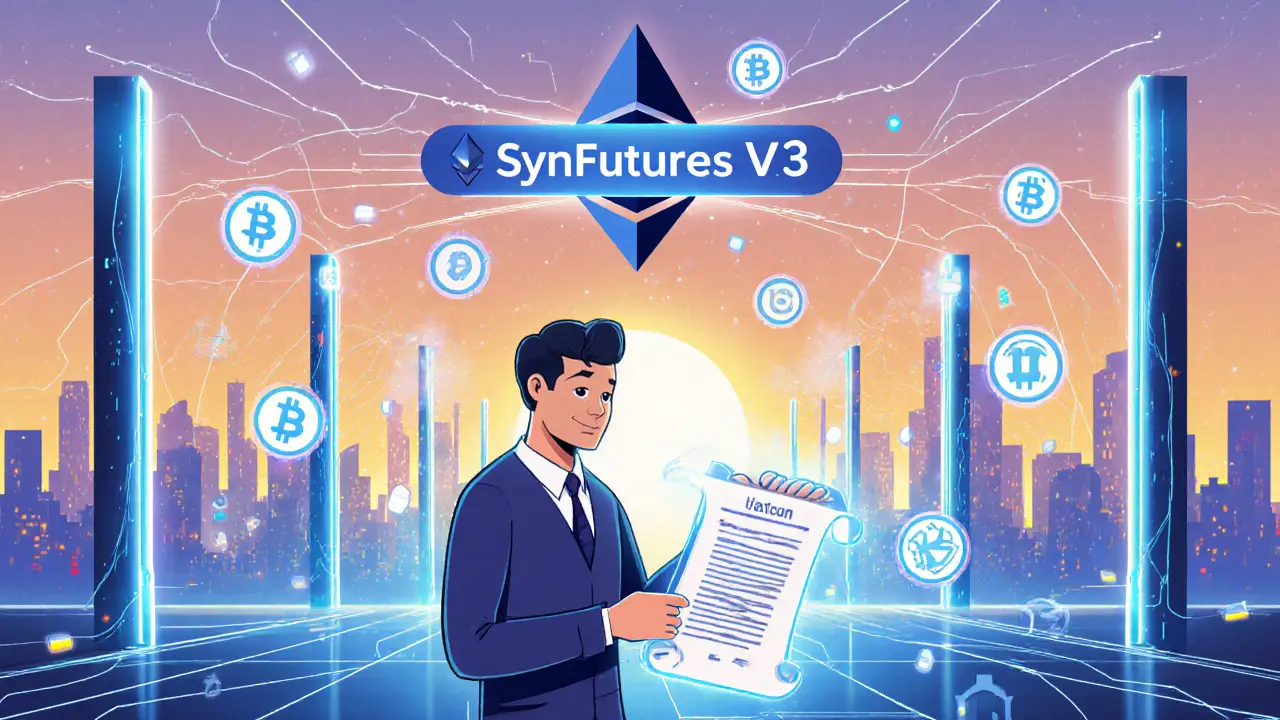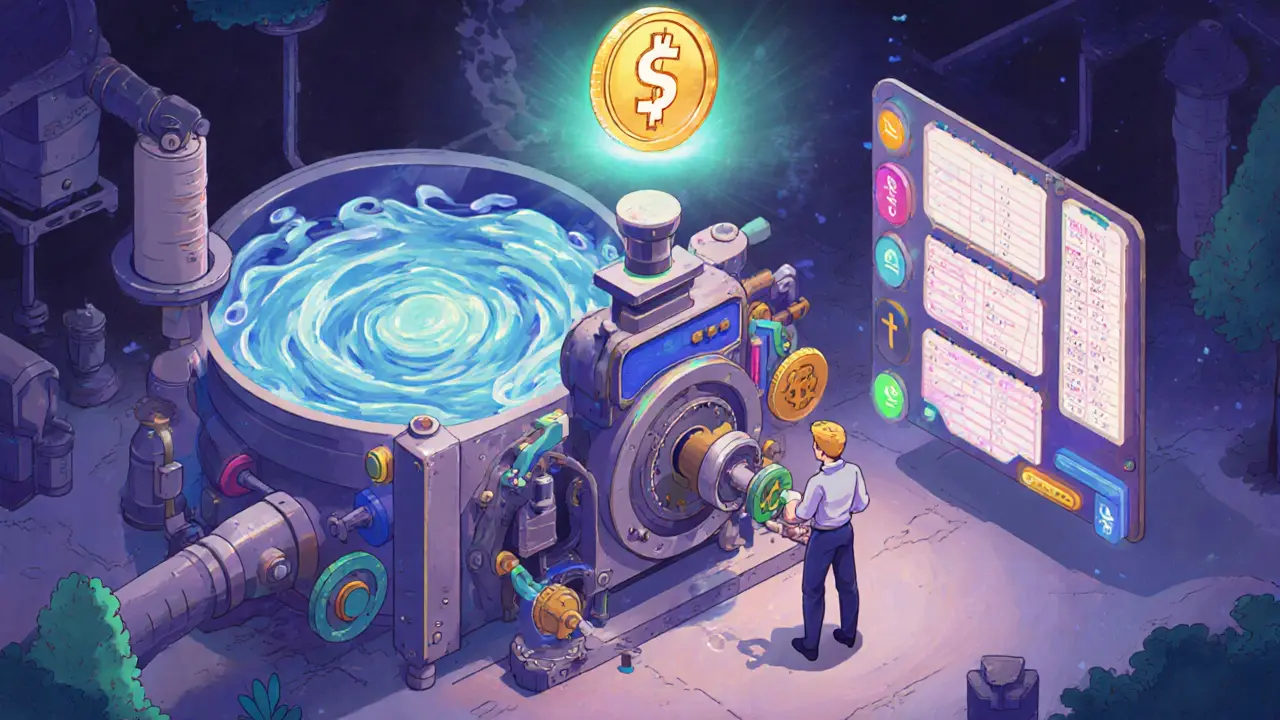Posted By Tristan Valehart On 12 Oct 2025 Comments (1)

SynFutures Futures Calculator
Futures Trade Calculator
Trade Results
Cryptocurrency traders are always on the hunt for the next platform that can give them more leverage, lower fees, and true ownership of their positions. SynFutures v3 promises all that and more, positioning itself as a fully on‑chain derivatives hub. This review breaks down the architecture, tokenomics, liquidity, and real‑world performance so you can decide whether the exchange lives up to the hype.
What is SynFutures v3?
SynFutures v3 is a decentralized derivatives trading platform that launched in December 2024. It runs on the Ethereum mainnet and lets users create and trade futures contracts on crypto, tokenized stocks, NFTs, and even real‑world assets. The platform is permissionless, meaning anyone with an Ethereum wallet can start trading without KYC.
The core innovation is the Oyster Automated Market Maker (oAMM) V3, a hybrid AMM‑order‑book engine that blends continuous liquidity provision with precise price discovery. By keeping the entire order‑matching process on‑chain, SynFutures aims for transparency that traditional centralized futures desks can’t match.
Key Players Behind the Project
- Pantera Capital - early‑stage VC with a long track record in crypto infrastructure.
- Polychain Capital - backs DeFi protocols that scale across multiple blockchains.
- Dragonfly Capital - focuses on projects that bridge traditional finance and Web3.
These firms bring not just capital but strategic connections that help SynFutures secure liquidity partners and cross‑chain bridges.
Technical Architecture & How Trading Works
At a high level, SynFutures v3 operates on three layers:
- Ethereum Base Layer - all contracts, including the order‑matching engine, are immutable and publicly auditable.
- oAMM V3 Engine - combines the constant‑product formula of classic AMMs with a discrete order book. Traders can place limit orders that sit on‑chain until they are filled, while market orders tap the AMM pool for instant execution.
- Governance & Staking Layer - the native $F token (ERC‑20) powers voting, fee discounts, and staking rewards.
This hybrid model solves two common DEX problems: low slippage for large trades (thanks to the order book) and consistent liquidity for small traders (thanks to the AMM). Because every trade is settled on‑chain, users can verify execution details directly on a block explorer.

Tokenomics: The Role of $F
The $F token serves three main functions:
- Governance - holders can propose and vote on protocol upgrades, fee structures, and new asset listings.
- Staking - locking $F in the protocol earns a share of trading fees (typically 0.05‑0.10% of each contract) and can unlock tiered fee discounts ranging from 5% to 25%.
- Utility - $F is used to pay gas‑optimized meta‑transactions for order placement, reducing the overall cost for frequent traders.
Supply is capped at 10billion tokens, with an initial distribution of 30% to the community, 25% to the founding team (vested over 3years), and the remainder allocated to liquidity incentives and venture backers.
Performance Metrics & Market Sentiment (Oct2025)
As of the latest snapshot, $F trades around $0.0121, giving the protocol a market cap of roughly $30million. Volatility sits at 37.44%, with a 14‑day RSI of 44.9 - indicating a mildly bearish short‑term outlook.
Technical indicators:
- 50‑day SMA: $0.0103
- 200‑day SMA: $0.0137
- Fear &Greed Index: 49 (Neutral)
These numbers suggest the token is in a consolidation phase, awaiting either a macro‑level market rally or a breakout driven by platform adoption.
How Does SynFutures Compare to Competing DEX Derivatives?
| Feature | SynFutures v3 | dYdX | Perpetual Protocol |
|---|---|---|---|
| Underlying Chain | Ethereum (L2 Optimism support) | Ethereum (Layer‑2 StarkEx) | Multiple (Ethereum, Arbitrum, zkSync) |
| Liquidity Model | Hybrid oAMM+on‑chain order book | Pure order book (off‑chain matching) | Pure AMM (virtual AMM) |
| Max Leverage | Up to 20× | Up to 25× | Up to 10× |
| Governance Token | $F (ERC‑20) | DYDX (ERC‑20) | PERP (ERC‑20) |
| Fee Discount for Stakers | 5‑25% based on stake | Flat 10% for $DYDX holders | 5% for $PERP stakers |
| Asset Coverage | Crypto, tokenized stocks, NFTs, real‑world assets | Major crypto pairs only | Crypto & some tokenized assets |
The hybrid liquidity model gives SynFutures a unique edge: traders benefit from low slippage on large positions while still enjoying the instant execution of AMM pools for smaller orders.
Pros, Cons, and Risks
| Pros | Cons |
|---|---|
| Fully on‑chain order matching ensures transparency. | Higher gas costs on Ethereum mainnet during peak demand. |
| Hybrid oAMM V3 reduces slippage for large trades. | Liquidity is still growing; deep book not yet on par with centralized exchanges. |
| Broad asset coverage, including tokenized real‑world assets. | Regulatory uncertainty around synthetic derivatives could affect future listings. |
| Governance and staking create real incentives for token holders. | Token price volatility makes fee‑discount calculations unpredictable. |

Getting Started: Step‑by‑Step Walkthrough
- Connect a Web3 wallet (MetaMask, WalletConnect, or Coinbase Wallet) to the SynFutures app.
- Approve $F token usage in the staking contract if you plan to earn rewards.
- Deposit collateral (ETH, USDC, or other supported assets) into the margin vault.
- Select the desired futures contract from the market list - e.g., BTC‑USD perpetual.
- Choose order type: market (instant via AMM) or limit (on‑chain order book).
- Set leverage (up to 20×) and confirm the transaction. The trade settles on‑chain in seconds.
- Monitor position, add or reduce collateral, and close when ready.
All steps are final on the blockchain; there’s no “cancel” button after a transaction is mined, which adds a layer of security but also requires careful execution.
Future Roadmap & Outlook
SynFutures has outlined three milestones for 2025‑2026:
- Q42025: Launch of cross‑chain bridges to allow margin deposits from Binance Smart Chain and Solana.
- Q22026: Introduction of “Synthetic Real‑Estate” contracts, expanding the asset universe beyond digital assets.
- Q42026: Full rollout of a DAO‑governed insurance fund to protect traders against smart‑contract failures.
If these upgrades land on schedule, the platform could attract institutional traders looking for on‑chain derivatives with built‑in risk mitigation.
Quick Takeaways
- Hybrid oAMM+order book gives better price discovery than pure AMM DEXes.
- Strong VC backing (Pantera, Polychain, Dragonfly) adds credibility.
- Liquidity is growing but still behind centralized giants.
- $F token price is volatile; staking rewards offset some risk.
- Regulatory environment remains the biggest wildcard.
Frequently Asked Questions
Is SynFutures v3 truly decentralized?
Yes. All core contracts - the order‑matching engine, liquidity pools, and governance token - are deployed on Ethereum and cannot be altered without a DAO vote. No custodial accounts are required.
What assets can I trade on SynFutures?
Beyond major crypto pairs, the platform supports tokenized stocks, NFTs, and real‑world assets like gold or real‑estate tokens, provided they have been vetted by the governance process.
How does the fee discount work for $F stakers?
Stakers lock $F in the protocol’s staking contract. Depending on the amount, they receive a tiered discount ranging from 5% (≤10,000 $F) up to 25% (≥1million $F) on trading fees. The discounts are applied automatically at trade execution.
What are the main risks of using SynFutures?
Key risks include Ethereum gas spikes, smart‑contract bugs (though audits have been performed), regulatory crackdowns on synthetic derivatives, and token price volatility affecting fee discounts and staking rewards.
Can I trade on SynFutures with a mobile wallet?
Yes. The web UI is responsive, and WalletConnect enables connection from mobile wallets like Trust Wallet or MetaMask Mobile.

Jade Hibbert
October 12, 2025 AT 09:32I dug into the hybrid oAMM thing and, honestly, it feels like a fancy blender for trades-mixes the smoothness of AMM with the sharp cuts of an order book.
It’s cool that you can drop a limit order and let it sit on‑chain, but also slam a market order into the pool when you’re in a hurry.
The only thing is you might see a few extra gas fees when the contracts talk to each other.
Still, for folks who hate slippage and love transparency, it’s a decent compromise.
Just watch the gas spikes, or you’ll end up paying more than the spread.